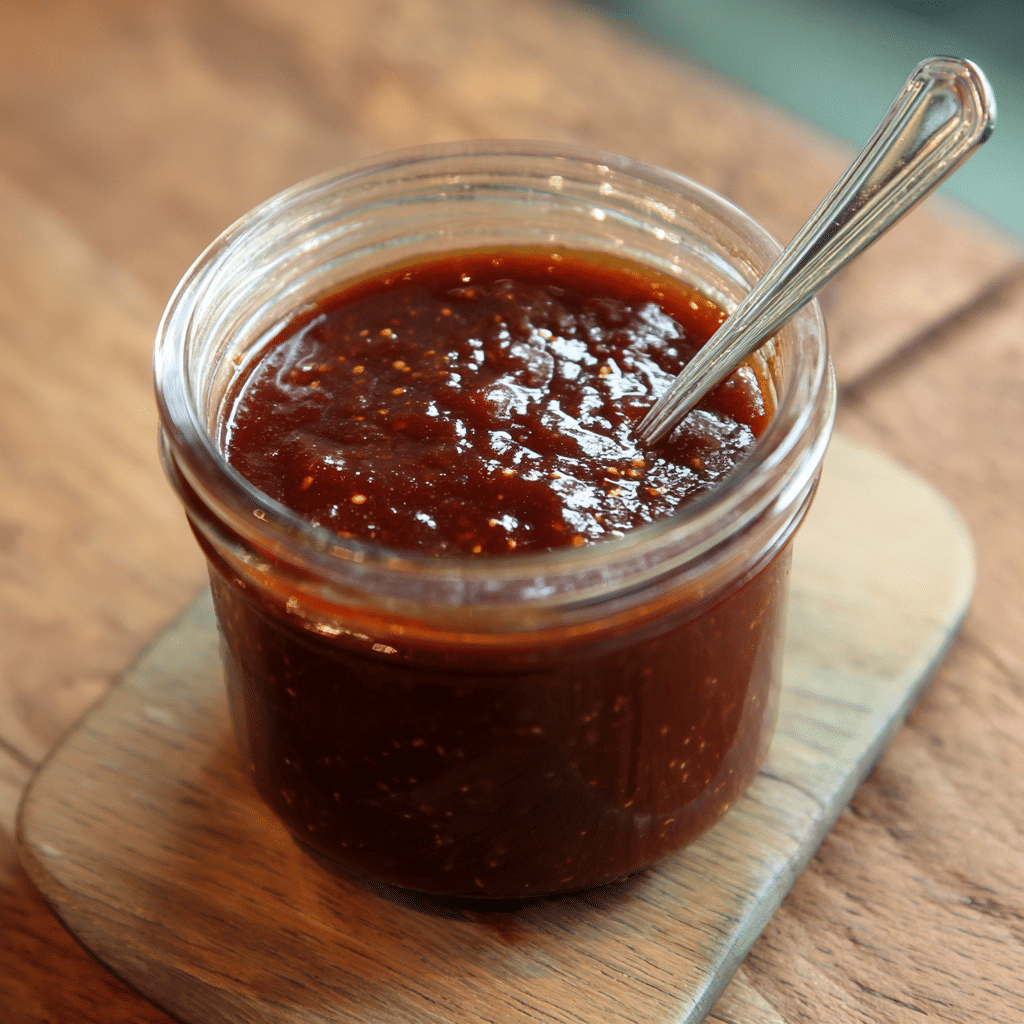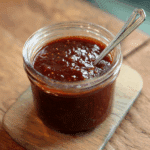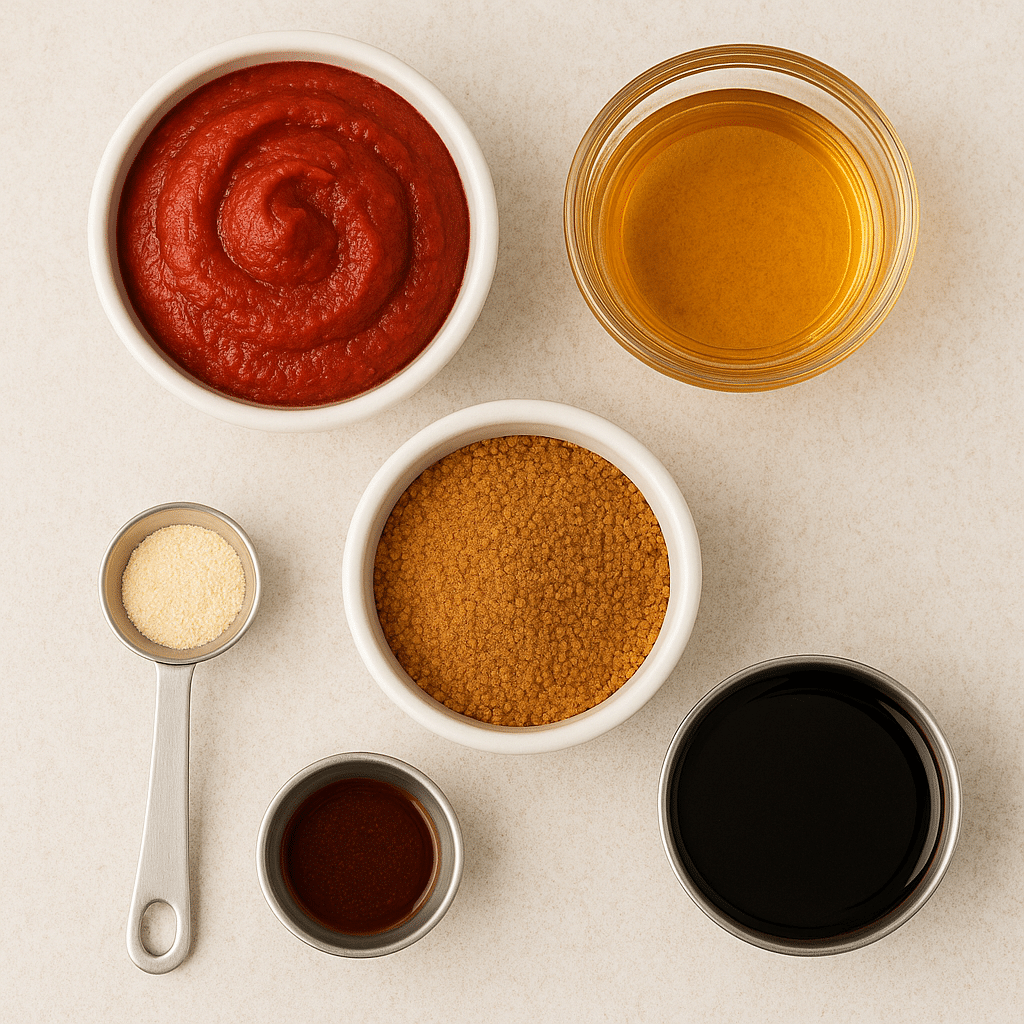Looking to savor the bold flavors of barbecue without overloading on sugar or calories? This article dives deep into the delicious world of low calorie barbecue sauce, offering not only a mouthwatering homemade recipe but also valuable insights on healthy swaps and ingredients that keep the taste sky-high and the calories low. Whether you’re prepping for summer cookouts or just want a clean sauce option year-round, this guide has you covered.

Low Calorie Barbecue Sauce: Flavor Without the Guilt
The Story Behind My Favorite Low Calorie Barbecue Sauce
Growing up, our backyard was a sacred space during summer. My mom’s signature barbecue spread wasn’t complete without her sticky-sweet sauce bubbling away in a saucepan.
That smell—rich tomatoes, tangy vinegar, warm garlic—was my signal to drop everything and run to the table.
But as an adult trying to stay mindful of what I eat, I realized most store-bought sauces were overloaded with sugar, salt, and preservatives.
That’s when I started testing a low calorie barbecue sauce I could actually feel good about.
After a dozen experiments, I landed on this version—sweetened with coconut sugar, made vibrant with tomato paste, and just 30 calories per serving.
It brings me right back to those backyard moments, but now it fits beautifully into my healthier lifestyle.
For anyone aiming to build meals that align with balanced nutrition, this Healthy Eating Plate guide from Harvard is a great visual reference.
This sauce isn’t just a diet trick; it’s rich, balanced, and deeply satisfying. I drizzle it over grilled chicken, mix it into jackfruit sandwiches, or use it as a base in dishes like this barbecue chicken mac and cheese for a lighter twist on a classic. It even pairs beautifully with vegetarian options like smoked cauliflower steaks, showing just how versatile and flavorful a healthier BBQ sauce can be.
Why You’ll Love This Low Calorie Barbecue Sauce
The best thing about this low calorie barbecue sauce? It’s completely homemade. That means no high fructose corn syrup, no processed thickeners, and definitely no mystery ingredients. You control the sweetness and spice levels, and it takes just 20 minutes on the stovetop.
This version uses coconut sugar, which adds gentle sweetness without spiking your blood sugar as rapidly as refined sugars. Tomato paste offers concentrated flavor, and a splash of apple cider vinegar brightens the whole batch. Want it smoky? Add a drop of liquid smoke or a pinch of chipotle powder—just like in our chipotle barbecue sauce recipe. Craving something even more tangy? Swap in more vinegar, as we explore in the vinegar-based barbecue sauce variations.
Nutrient-Packed Without Sacrificing Taste
Traditional BBQ sauces often have 70–100 calories per two tablespoons—mostly from sugars. This sauce slashes that down to about 30 calories per serving without losing any of the depth you expect from a rich, complex barbecue blend. It’s naturally gluten-free and easy to adapt into other dietary preferences. If you’re after something low sodium too, consider combining this recipe with ideas from our low sodium barbecue sauce post to create a version that’s heart-healthy as well.
Variations and Smart Ingredient Swaps for Low Calorie Barbecue Sauce
Healthier Sweeteners to Keep Calories Down
Print
Low Calorie Barbecue Sauce
- Total Time: 25 minutes
- Yield: 1 cup 1x
- Diet: Low Calorie
Description
This low calorie barbecue sauce is a rich, tangy, and satisfying alternative to sugary store-bought BBQ sauces. With only 30 calories per serving, it’s perfect for grilled meats, veggies, or healthy meal prep.
Ingredients
6 oz Tomato Paste
2 tablespoons Apple Cider Vinegar or white vinegar
4 tablespoons Worcestershire Sauce (Annie’s vegan version)
½ cup Water
½ teaspoon Garlic Powder
1 tablespoon Coconut Sugar (or sweetener of choice)
Instructions
1. Heat a small saucepan over medium heat.
2. Add all ingredients to the saucepan and stir well to combine.
3. Bring the mixture to a light bubble, then reduce the heat to low.
4. Simmer uncovered for 20 minutes, stirring occasionally.
5. Remove from heat, let cool, and transfer to a clean glass jar.
6. Store in the refrigerator for up to 10–14 days. Use as desired.
Notes
For added heat, stir in chipotle powder or hot sauce.
For a smokier profile, add a drop of liquid smoke.
Use tamari instead of Worcestershire for a gluten-free version.
- Prep Time: 5 minutes
- Cook Time: 20 minutes
- Category: Sauces
- Method: Simmering
- Cuisine: American
Nutrition
- Serving Size: 2 tbsp
- Calories: 30
- Sugar: 4g
- Sodium: 283mg
- Fat: 0.1g
- Saturated Fat: 0.02g
- Unsaturated Fat: 0.04g
- Trans Fat: 0g
- Carbohydrates: 7g
- Fiber: 1g
- Protein: 1g
- Cholesterol: 0mg
When it comes to crafting the perfect low calorie barbecue sauce, sugar is often the ingredient that needs the biggest overhaul. Most store-bought sauces pack in a shocking amount of refined sugar, pushing the calorie count higher than necessary. In this homemade version, I stick with coconut sugar—a more natural, lower-glycemic option that still brings a subtle, caramelized flavor.
But you’re not stuck with one choice. If you’re looking to cut even more calories, try monk fruit sweetener or erythritol, both of which blend seamlessly into sauces while keeping that sweet BBQ bite. A small spoonful of maple syrup or honey can also add richness while still keeping your sauce lower in calories than traditional versions.
This flexibility is one of the reasons I love making low calorie barbecue sauce at home. I can control the ingredients and avoid the hidden sugars that lurk in bottles off the shelf. And the result? A flavorful, guilt-free condiment that enhances any dish.
Flavor Additions to Personalize Your Sauce
Once you’ve nailed the sweetener, it’s time to play with bold flavors. Want to add heat? Stir in chipotle powder, chili flakes, or your favorite hot sauce. Want a smoky edge? A dash of liquid smoke transforms your low calorie barbecue sauce into something that tastes like it just came off the grill.
For a zesty variation, I often follow cues from our Asian barbecue sauce, adding ginger and soy sauce for umami depth. And if you’re after bold Southern flavor, look to our cajun BBQ sauce recipe for inspiration—just be sure to keep your ingredient swaps clean and calorie-conscious.
If you’re avoiding gluten or animal products, check your Worcestershire sauce. I use a vegan version, but you can also swap it with tamari or coconut aminos to keep your low calorie barbecue sauce both healthy and inclusive. For sodium-conscious cooks, reduce the Worcestershire and increase the vinegar or lemon juice for tang without the salt—like we explored in our gluten-free barbecue sauce.
Each ingredient tweak offers a new layer of flavor while maintaining the low calorie integrity of your homemade barbecue sauce.
The Recipe: Ingredients & Step-by-Step Instructions
Ingredients for Low Calorie Barbecue Sauce
This low calorie barbecue sauce is made with simple pantry staples. Every ingredient is intentional—low in calories, big on flavor.

- 6 oz tomato paste
- 2 tablespoons apple cider vinegar (or white vinegar)
- 4 tablespoons Worcestershire sauce (I use Annie’s for a vegan-friendly option)
- ½ cup water
- ½ teaspoon garlic powder
- 1 tablespoon coconut sugar (or any preferred sweetener, adjusted to taste)
You can adjust the vinegar for more tang or increase the sweetener slightly if you like it a bit sweeter.
Step-by-Step Cooking Instructions
Here’s how to make your own bold, smoky, and satisfying low calorie barbecue sauce at home in under 30 minutes:
- Heat your saucepan.
Place a small saucepan over medium heat and allow it to warm for about 1 minute. - Add all ingredients.
Pour in the tomato paste, vinegar, Worcestershire sauce, water, garlic powder, and coconut sugar. Stir to combine well. - Bring to a bubble.
Once the sauce begins to bubble lightly around the edges, give it a good stir.

- Simmer slowly.
Reduce the heat to low and let the sauce simmer uncovered for 20 minutes, stirring occasionally. This step allows the flavors to meld and the sauce to thicken slightly. - Cool and store.
Once done, let the sauce cool for a few minutes. Transfer to a clean glass jar or airtight container. Refrigerate and use within 10–14 days.
Best Ways to Use Low Calorie Barbecue Sauce in Real Meals
Everyday Dishes That Benefit from Low Calorie Barbecue Sauce
Once you’ve got a jar of low calorie barbecue sauce in your fridge, you’ll be surprised how often you reach for it. It’s not just a condiment—it’s a flavor booster. Slather it on grilled chicken or turkey burgers, toss it with roasted veggies, or even stir it into your favorite slow cooker meals. You’ll get that sweet-and-smoky hit without sabotaging your nutrition goals.
One of my go-to dinners is BBQ chicken breast over roasted cauliflower, using this low calorie barbecue sauce as both a marinade and finishing glaze. It’s simple, fast, and feels indulgent—without the actual indulgence. For plant-based options, try coating tofu or tempeh in the sauce and baking until caramelized. It’s also the perfect finish to a wrap with shredded lettuce, grilled veggies, and lean protein.
Another favorite of mine is using it as a mix-in for lighter casseroles. Think of something like this indulgent barbecue chicken mac and cheese—only made with whole wheat pasta and your homemade sauce. You cut calories and keep all the comfort.
Meal Prep and Smart Pairings

One of the biggest benefits of low calorie barbecue sauce is how well it fits into meal prep. I like making a double batch on Sunday and using it throughout the week. Whether it’s grilled chicken, pulled jackfruit, or baked tofu, having a healthy, flavorful sauce ready to go makes sticking to your goals much easier.
According to the Cleveland Clinic, planning meals around flavorful, lower-calorie staples like this sauce can help maintain calorie awareness without compromising taste.
Pair your sauce with fiber-rich sides like roasted sweet potatoes or brown rice. Or create a balanced bowl: a scoop of grains, grilled protein, steamed greens, and a drizzle of sauce. It’s quick, satisfying, and anything but boring. For something totally different, try it on smoked cauliflower steaks for a meatless meal with attitude.
This sauce also makes a great dipping option for grilled skewers or air-fried chicken bites. When made at home, you don’t have to worry about added oils, syrups, or excess sodium—something that can’t be said for most commercial options.
Bottom line? This low calorie barbecue sauce is as versatile as it is tasty. With just a little planning, you’ll find ways to work it into breakfast, lunch, and dinner—and never feel like you’re missing out.
Storage, Shelf Life & Final Tips for Your Low Calorie Barbecue Sauce
How to Store Your Homemade Low Calorie Barbecue Sauce
After you whip up a batch of this delicious low calorie barbecue sauce, proper storage is key to keeping it fresh and flavorful. Once your sauce has simmered and cooled slightly, transfer it to a clean glass jar or airtight container. I always prefer using a mason jar—it seals tightly, doesn’t retain smells, and fits easily in the fridge door.
Refrigerated, this low calorie barbecue sauce will stay fresh for about 10 to 14 days. Always use a clean spoon when scooping some out to prevent introducing bacteria. And if you’re like me and go through it quickly, you might find yourself making a new batch every week!
Want to extend the life a little more? You can freeze it! Divide the sauce into small silicone molds or freezer-safe containers. Once frozen, pop out a cube or two whenever you need a quick flavor boost.
Final Tips for Flavor and Nutrition Success
As with any recipe, the magic is in the details. To get the most out of your low calorie barbecue sauce, taste as you go—especially when adjusting sweetness or acidity. Everyone’s palate is different, and this recipe is meant to be flexible.
If you prefer a thinner sauce, just add a little extra water while simmering. Like it thicker? Simmer uncovered a bit longer. Don’t be afraid to customize it. The joy of homemade sauces is making them your own—something you’ll never get from a store shelf.
Need more inspiration? Our Louisiana BBQ shrimp sauce and buffalo wild wings chipotle rub posts show just how far you can take a simple sauce with regional twists and bold ingredients.
Most importantly, don’t let your healthy eating goals take the joy out of flavor. This sauce is proof that you can eat well, feel great, and still enjoy the comforting, crave-worthy experience of barbecue—without the sugar crash or calorie overload.
Frequently Asked Questions About Low Calorie Barbecue Sauce
What barbecue sauce is low in calories?
A low calorie barbecue sauce is typically homemade using wholesome ingredients like tomato paste, vinegar, and a low-glycemic sweetener like coconut sugar. Store-bought options often contain added sugars and preservatives, which can spike the calorie count. Our easy homemade version comes in at just 30 calories per serving—perfect for health-conscious eaters.
What is the most low calorie sauce?
While many sauces can be lightened up, mustard, salsa, and vinegar-based sauces usually rank among the lowest in calories. However, for those craving bold barbecue flavor, our low calorie barbecue sauce offers the richness of traditional BBQ sauce without the high sugar and fat content.
Can barbecue be low in calories?
Absolutely. Barbecue can be very low in calories when lean proteins (like chicken breast or tofu) are used and paired with lighter sauces and sides. Swapping traditional barbecue sauce for a low calorie barbecue sauce is one of the easiest ways to enjoy the flavor without unnecessary calories.
What is a healthy substitute for barbecue sauce?
A healthy substitute could be a vinegar-based sauce, a mustard glaze, or even salsa. But when you’re looking for that smoky-sweet profile of classic barbecue, a homemade low calorie barbecue sauce—like the one shared here—is the best alternative. It lets you enjoy the taste while sticking to your health goals.
Conclusion
There’s something deeply satisfying about crafting your own low calorie barbecue sauce—a sauce that not only tastes incredible but supports your health journey, too. Whether you’re grilling chicken, dressing up veggie bowls, or meal prepping for the week ahead, this versatile sauce brings the flavor without the guilt.
If you’re inspired to experiment more, try it with our Hawaiian BBQ chicken or even drizzle it over creative fusion dishes like BBQ chicken musubi. There’s a world of possibility waiting in every spoonful.
